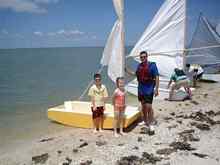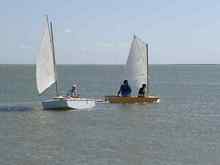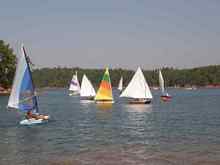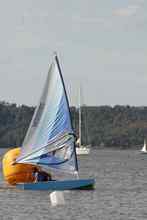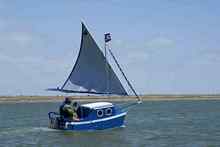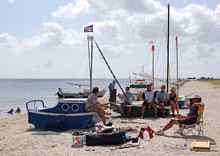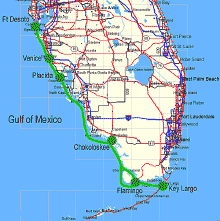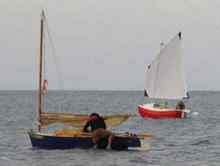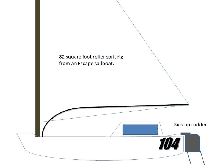
| sails |
| plans |
| epoxy |
| rope/line |
| hardware |
| canoe/Kayak |
| sailmaking |
| materials |
| models |
| media |
| tools |
| gear |
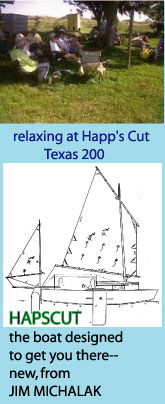 |
 |
| join |
| home |
| indexes |
| classifieds |
| calendar |
| archives |
| about |
| links |
| Join Duckworks Get free newsletter Comment on articles CLICK HERE |
|
|
| A Puddle Duck and the Everglades Challenge |
by Scott Widmier - Kennesaw, Georgia - USA |
A Science ExperimentHere is the formula I wish to test PDR + EC = ?
My Puddle Duck ExperienceThe Puddle Duck Racer was designed by David (Shorty) Roth and an easy and fun developmental class sail boat that is both extremely easy to build and sail. It is essentially a four foot by eight foot box with rocker on the bottom making it a very stable boat for its size. There are no lifting foils allowed in this class and the bottom ten inches of the boat has to match the class profile but beyond that anything goes. My first experience with these boats was in 2006 when I decided to attend the Puddle Duck World Championship and Duckworks Messabout. Of course I couldn't show up without a boat (for some reason my wife calls this pathological) but I also didn't trust my trailer for the 15 hour drive from Atlanta. Besides, I had gotten this idea in my head of flying out to Houston and building a boat in my parent's driveway in The Woodlands, TX for this event. At this point I had never seen a puddle duck on the water or off and I had no idea what they were like to sail other than what had been posted online. I designed a side airbox floatation Puddle Duck called 3 sheets to the wind (my wife's requirement) and premade the sail in Georgia before flying out to Houston with a suitcase full of tools. Two long days later, I strapped my new puddle duck, hull 104, to the roof of my parents van and we started the drive to Magnolia Beach. My first sail on a duck was enjoyable and I ended up placing third in the Puddle Duck Worlds competition despite never having raced. Once the race and messabout was done, I found a father and son who came to watch the races and gave my boat to them before flying home.
I had a lot of fun building, sailing, and giving away the Puddle Duck but I wasn't really all that motivated to build another. I had just bought a larger boat and was learning about racing and cruising it with the sailing club I had joined, Southwinds Sailing Club, and I didn't have time to spend on an odd little shoebox shaped boat. Things changed, however, in 2009 when I was contacted by Tim Cleary who was looking for a location for the 2009 Puddle Duck Worlds Championship. The Worlds Championship goes to the person who hosts the largest regional Puddle Duck competition in the previous year and Tim had won that honor. By this time I was very familiar with Lake Allatoona so was able to make some suggestions and get the troop of Sea Scouts my sailing club supported to volunteer to run the races. I showed up for the races in my large sailboat with a mouseboat on deck and towing a little experimental 12 foot boat I had designed. I did not have a Puddle Duck racer at the time but I again noted how much fun everyone had racing these diminutive boats despite the fact that they are not the fastest or most challenging sailing boat out there. I left worlds not only determined to build another PDracer but to get some members of my club and the Sea Scouts to build ones as well in order to have other boats to sail against! So, I designed a new side-airbox duck wanting to try 12 inch high sides with 12 inch wide airboxes. I built the duck over the course of a week and rigged her with a windsurfer sail and hit the lake. I ended up naming this boat Mariah, the name of the wind in the movie "Paint your Wagon" because the first several times I went sailing in her I always had too much wind. I learned a lot from this boat about rudder design, mast rake, and needed reinforcements. I also learned how easy it is to submarine a low-sided puddle duck racer when sailing downwind with a sail you are unable to reef! As I grew familiar with her and made the necessary tweeks, I really started to enjoy sailing her over some of my other boats. In 2010 I hosted the Red Top Regionals at Red Top Mountain on Lake Allatoona. I was hoping for a great turnout as our Sea Scout troop had sold a number of kits but, unfortunately, a lot of those kits hadn't gotten finished. We ended up with eight boats including the champion from 2009 Worlds, Shawn Payment. It was a light wind race and, despite having one of the smaller sails, I ended up winning all three races handily due to my ability to sail much closer to the wind than the other boats. I believe it was a combination of the windsurfer sail along with the large rudder and daggerboard I had.
In 2011 I talked one of my club members in to driving thirteen hours to Eufala, OK with me in order to participate in the Puddle Duck Worlds championship being hosted by Jackie and Mike Monies. They hosted an absolutely wonderful event other than ordering a bit too much wind for the races. Ironically, we were again sailing off the leeward shore which kept the waves down but did lead to concerns about getting back to the beach should the boat break. I sailed a good part of Friday getting familiar with the conditions and practicing for the races on Saturday. I noticed my thin aluminum flagpole mast was taking a permanent bend due to the high winds but was otherwise happy with my performance. Saturday came and I made my way out to the start line only to notice the bend in my mast had turned into a kink indicating imminent failure! I sailed back to shore while I could and bought a fiberglass radio antenna someone had contributed to the boat shed. Unfortunately, in my rush I didn't think through the mechanics well. I sailed out with my new mast to the start line, crossed it, cranked down on the mainsheet and crack, my new mast broke at the base. So, I got towed back to the beach. Over lunch I frantically turned another fiberglass CB antenna into a mast and ended up sailing out to the start line two minutes after everyone started. As had happened at Red Top Regionals, I was able to outpoint everyone else to windward and ended up winning the second and third race. I gave that Puddle Duck away to John Huft before leaving Oklahoma but this time I was determined to build another one and my drive home was occupied by design thoughts.
So, there I was needing to build a new duck with lots of design ideas floating around in my mind. There was the Rubic's Duck design that could fold up and come apart to fit into the trunk of a car, the Duck Tape Duck made (you guessed it) from Duck Tape, the windsurfing Duck, and a Duck Duck made to look like the WWII amphibious vehicles. Into this maelstrom of indecision came a brief email from Shorty asking if I would consider building a duck for the Everglades Challenge. My whirling mind fastened on this idea and I was off. There is a history of doing cruises in these diminutive squared off boats and it is all about Perseverance. That is the key to success in going any distance in a boat that averages three knots an hour especially when in an event with almost any other kind of sailboat. Jason Nabors has garnered the most fame in his appropriately named "Tenacious Turtle" but there are a whole group of skippers in the hall of fame for completing the 200 mile long Texas 200 in a Duck. These skippers would be the first to leave the beach in the morning and the last to arrive but they persevered to well-deserved cheers at the finish line on Magnolia Beach.
Now, one feature of the Texas 200 does help contribute to the success of these skippers and their Puddle Ducks. The prevailing wind is from the west and the majority of the 200 miles is done downwind. This raises the question of if Puddle Ducks would be able to do this type of challenge if there was a significant amount of windward work? This question has kept Puddle Duckers occupied for many hours on discussion forums and, inevitably, talk turns towards testing the duck cruising concept out on the father of all endurance cruises, The Everglades Challenge. The Everglades ChallengeThe Everglades Challenge is a 300 mile endurance race starting from Ft. Desoto in Tampa Bay and ending up in Key Largo. Every March, a variety of boats from kayaks to carbon fiber catamarans line the beach at Ft. Desoto waiting for the early morning start to a challenging adventure and does this event deliver! There are many different challenges to be faced along this course some of them provided by design of the race originator, Chief, and some by nature.
Nature can throw a lot of challenges in the competitor's way as I learned to my sorrow in my, (Plumbcrazy is my watertribe name) 2011 attempt. It seemed like, at first, nature was going to be kind with some of the warmest temperatures experienced for the start of the Everglades Challenge. Little did I realize that the unseasonably warmer temperatures would bring winds from the south instead of the winds from the North pushing me to my destination. In addition, these warmer temperatures made for unsettled weather making for nasty wave/wind combination. Because the winds were southerly at the start, I decided to sail outside in the Gulf where there was more room to tack rather than the more protected intercoastal waterways. I also figured the warmer weather would bring powerboaters and their associated wakes out in droves in the intercoastal. I made good progress in some very strong winds at the start only to be stranded for many hours in very light intermittent breezes early afternoon through the evening. This is where I made my first mistake, Instead of stopping for a decent meal and a little bit of rest, I decided to forge on ahead. One of those man-made challenges I mentioned earlier is a deadline of making it 60 miles to the first checkpoint by Sunday at noon (29 hours) and I knew if I didn't sail throughout the night I wouldn't make it. In hindsight I realized there were a lot of other competitors who were going to miss this time limit given the weather which would force the race committee to extend it.
As the night progressed to morning there was a mounting swell coming from storms just offshore combined with the wind coming back with a vengeance. On one of the tacks, I had to sail straight into this swell almost bringing me to a standstill every time a wave passed. My lack of rest combined with a speed towards destination of one mile per hour and an almost disastrous stop to tie in a reef combined and led me to beach the boat and call for pickup from my shore crew. Now, Chief had said that if you feel like dropping out get some rest first and, as it turns out, he was right. As I sat dozing on the beach waiting for my ride the wind began to moderate and shift making for a short reach to Stump Pass, I had stopped a mile short, and along came Scamp piloted by Mike Monies and Andrew Linn. I learned later that Chief, who I spotted just before bailing, was also having problems in the same stretch of water I was in. He pulled up on the beach a half mile back from where I stopped and accepted a lift to the inter-coastal from some strangers. This was considered legal because it was not prearranged. If I had realized and had a lighter boat I could have done the same. As it turned out, 2011 was one of the toughest years for the Everglades Challenge with more than half the competitors dropping out including Gary Blankenship who has successfully done the event many times. Andrew Linn and Mike Monies ended up being stranded on the mud when easterly winds blew all of the water out of Florida Bay and didn't finish. Several competitors called a weather hold at Sanibel Island before venturing into open water due to the violent weather. Not a great year to complete the challenge in but a great year to learn and prepare for the next challenge. I learned several important things from this attempt. First, mental preparation is as important, if not more important, than physical preparation. You have to go into this with the right mindset and realistic expectations. Second, it is very important to stop every once in awhile to rest and have a decent meal. Third, it is very important to have a comfortable boat since you are going to be spending hours in it. Finally, Chief set this up to mimic cruising in a small boat which means you can accept the help of strangers along the route. PuddleDuck and the Everglades ChallengeThe biggest barrier to doing the Everglades Challenge in the Puddle Duck is the limited time you have to make the Checkpoints, particularly the first. Again, you have roughly 60 miles to cover in 29 hours which seems doable in a boat that can average 3 to 4 miles per hour. However, what happens if the wind is light or you have to tack into the wind? You can't row a Duck much over 3 mph and 2 mph is more realistic into a headwind. There is no glide to that short wide boxy shaped hull. Tacking through 120 degrees is quite an accomplishment for a duck but this more than doubles the direct-line distance to your destination. Also, are you going to be able to sail 29 hours straight by yourself? This has led many a discussion board pundit to proclaim that the Everglades Challenge cannot be completed in a duck. Of course to some people, saying something can't be done is akin to throwing down a gauntlet hence the email I received from Shorty and the fact he is bouncing off the walls now that I have agreed to make the attempt. So, I have talked about some of the challenges to doing the Everglades Challenge in a Puddle Duck but it is now time to highlight some of the advantages. The first filter experienced is the requirement to launch the boat from above the waterline off the beach. Given the diminutive nature of the boat and its relatively light weight this shouldn't be a problem. This small size also means that rigging and de-rigging to get under bridges will not be a problem. The Puddle Duck is one of the best small boats I have ever been in for heavy weather sailing as the width of the boat relative to the length gives you excellent leverage to keep her on her feet. Also, the short length allows the boat to fit inside of troughs or on top of waves making for less pounding, if more vertigo inducing, ride. There is a reason small lifeboats can survive in seas that would rip apart a larger ship. Granted, the flat wave-slapping bow and tendency to submarine in strong winds do tend to negate the heavy weather advantage. The Outcome?Who knows what the outcome will be of adding a Puddle Duck to the Everglades Challenge. Odds do not favor completion if we have similar weather to 2011 but what if nature cooperates giving a nice tail-wind for most of the route? There are a number of requirements that have to come together in order for a successful run that can be controlled for and these fall into the categories of the boat, preparation, and strategy. The Boat:The Puddle Duck for the Everglades Challenge will not be a lightweight racing boat. It will need to be solid enough to shrug off nature but light enough to carry the skipper and a load of stores. It needs to be comfortable to sail since, no matter how nice nature is, the skipper will spend a lot of time in the boat. It needs to be able to sail in both light winds and heavy with a big but easily reef-able sail. The combination of sail and control surfaces needs to add up to a very close-winded duck able to make decent speed to windward. It needs to have some sort of efficient propulsion system when the wind is nonexistent, from the wrong direction, or for those times the mast needs to be lowered. Ideally, this propulsion should be usable when sailing the boat to provide a little extra speed and weatherliness. The duck needs to provide shelter from cold and wet while on the water while also keeping the skipper cool when it gets hot. Finally, the Puddle Duck for the Everglades Challenge needs to provide a comfortable and dry place to stretch out to sleep eliminating the need to search for a camp or set up a shelter. I am working on a design for a cruising duck that will hopefully meet all of the needs above. I will be detailing the design and the build process in my next article on the Everglades Challenge duck. I have also set up a yahoo group "ECpuddleduck" as a think tank to help me with the design and strategy of this attempt.
The Strategy:Given the tendency of a Puddle Duck's bow transom to slap the waves stealing all momentum, the first goal should be to seek out smooth waters wherever available. This means sticking to the intercoastal waters even when the immediate weather suggests going into the Gulf where there is more room to tack and/or more wind. As I learned in 2011, conditions change especially when you consider how long it will take a duck to sail outside. If you go back through the accounts of previous challenges, most competitors get into trouble when they are lured to outside passages and the weather changes. Also, you have to fight tide, wind, and resulting waves when trying to make it back into the intercoastal through passes like the infamous Gasparilla one. This strategy of sticking to the more constricted intercoastal waterways does require a boat that is able to point well and/or has a decent human propulsion system (the only type allowed) and I have some ideas on that I will share in the next article. As I learned in 2011, I must take rest breaks no matter how comfortable the boat is and how much or little progress I am making. Going without sleep can play bad tricks on your mind and do bad things to your judgment. Granted, the break when sailing to checkpoint 1 may be short of necessity but, even a short nap is better than none. Add to this the requirement to get out of the boat occasionally to stretch and walk. I will not ignore my physiological needs. Finally, persistence will be key! Please check into www.pdracer.com for more updates of my progress and to learn more about this great versatile little boat you can build. |
